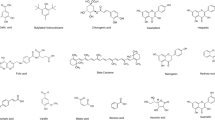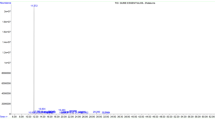Abstract
Background
Drosera spatulata is a source of many compounds such as naphthoquinones, phenolic acids, flavonoids, anthocyanins, and naphthalene derivatives. Unfortunately, the information regarding the biological activity and chemical profile of those compounds is still incomplete. Herein, we investigated the biological activity of 3-O-acetylaleuritolic acid (3-O-AAA) in cancer cell lines.
Methods
The cell viability of HeLa, HT-29, MCF7, and MCF12A cells was assessed using MTT assay. Proliferation potential was assessed using the clonogenic assay and flow cytometry. Migration modulation was tested using a scratch assay. Protein expression was analyzed by immunoblotting.
Results
3-O-AAA significantly inhibited the growth of all tested tumor cells. The results of the colony formation assay suggested cytostatic properties of the studied compound. The scratch assay showed that 3-O-AAA was an efficient migration inhibitor in a dose-dependent manner. Moreover, it caused modulation of mTOR, beclin1, and Atg5 proteins suggesting a possible role of the compound in autophagy induction.
Conclusion
Collectively, these results demonstrated that 3-O-AAA inhibited the proliferation and migration of cancer cell lines as well as contributed to autophagy induction showing some anticancer properties.
Graphic abstract








Similar content being viewed by others
Abbreviations
- 3-O-AAA:
-
3-O-acetylaleuritolic acid
- CPT:
-
Camptothecin
- DMSO:
-
Dimethyl sulfoxide
- MTT:
-
3-(4,5-Dimethylthiazol-2-yl)-2,5-diphenyltetrazolium bromide
- NMR:
-
Nuclear magnetic resonance
- PBS:
-
Phosphate-buffered saline
- PCNA:
-
Proliferating cell nuclear antigen
- WB technique:
-
Western blot technique
References
Zhang X, Chen LX, Ouyang L, Cheng Y, Liu B. Plant natural compounds: targeting pathways of autophagy as anti-cancer therapeutic agents. Cell Prolif. 2012;45:466–7.
Liu YQ, Tian J, Qian K, Zhao XB, Morris-Natschke SL, Yang L, et al. Recent progress on C-4-modified podophyllotoxin analogs as potent antitumor agents. Med Res Rev. 2015;35:1–62.
Gibson R. Carnivorous plants of New Zealand: a review. Carniv Pl Newslett. 1994;23(3):74–81.
Nakano M, Kinoshita E, Ueda K. Life history and coexistence of an amphidiploids, Drosera tokaiensis, and its parental species, D. rotundifolia and D. spatulata (Droseraceae). Plant Species Bio 2004;19:59–72.
Juniper BE, Robins RJ, Joel DM, editors. The carnivorous plants. London: Academic Press; Harcourt Brace Jovanovich; 1989.
Ferreira DTT, Andrei CC, Saridakis HO, Faria T, Vinhato E, Carvalho KE, et al. Antimicrobial activity and chemical investigation of Brazilian Drosera spp. Mem. Inst. Oswaldo Cruz Rio de Janeiro 2004;99:753–755.
Krenn L, Beyer G, Pertz HH, Karall E, Kremser M, Galambosi B, et al. In vitro antispasmodic and anti-inflammatory effects of Drosera rotundifolia. Arzneimittelforschung. 2004;54:402–5.
Fukushima K, Nagai K, Hoshi Y, Masumoto S, Mikami I, Takahashi Y, et al. Drosera rotundifolia and Drosera tokaiensis suppress the activation of HMC-1 human mast cells. J Ethnopharmacol. 2009;125:90–6.
Zenk MH, Fürbringer M, Steglich W. Occurrence and distribution of 7-methyljuglone and plumbagin in the droseraceae. Phytochemistry. 1969;8(11):2199–200.
Culham A, Gornall RJ. The taxonomic significance of napthoquinones in the Droseraceae. Biochem Syst Ecol. 1994;22:507–15.
Budzianowski J. Naphthouinones of Drosera spathulata from in vitro cultures. Phytochemistry. 1995;40:1145–8.
Egan PA, van der Kooy F. Phytochemistry of the carnivorous Sundew genus Drosera (Droseraceae) future perspectives and ethnopharmacological. Chem Biodivers. 2013;10:1774–90.
Braunberger Ch, Zehl M, Conrad J, Wawrosch Ch, Strohbach J, Beifuss U, et al. Flavonoids as chemotaxonomic markers in the genus Drosera. Phytochemistry. 2015;118:74–82.
Budzianowski J, Skrzypczak L, Kukułczanka K. Phenolic compounds of Drosera intermedia and Drosera spatulata from in vitro culture. Acta Hortic. 1993;330:277–80.
Zehl M, Braunberger C, Conrad J, Crnogorac M, Krasteva S, Vogler B, Beifuss U, et al. Identification and quantification of flavonoids and ellagic acid derivatives in therapeutically important Drosera species by LC-DAD, LC-NMR, NMR, and LC-MS. Anal Bioanal Chem. 2011;400(8):2565–76.
Ichiishi S, Nagamitsu T, Kondo Y, Iwashina T, Kondo K, Tagashira N. Effects of macro—components and sucrose in the medium on in vitro red—color pigmentation in Dionaea muscipula Ellis and Drosera spatulata Labill. Plant Biotechnol. 1999;16:235–8.
McGaw LJ, Lall N, Hlokwe TM, Michel AL, Meyer JIM, Eloff JN. Purified compounds and extracts from Euclea species with antimycobacterial activity against Mycobacterium bovis and fast-growing mycobacteria. Biol Pharm Bull. 2008;31:1429–33.
Poppinga S, Hartmeyer S, Masselter T, Hartmeyer I, Speck T. Trap diversity and evolution in the family Droseraceae. Plant Signal Behav. 2013;8:e24685.
Mathabe MC, Hussein AA, Nikolova RV, Basson AE, Meyer JJ, Lall N. Antibacterial activities and cytotoxicity of terpenoids isolated from Spirostachys africana. J Ethnopharmacol. 2008;116:194–7.
Meyre-Silva C, Mora TC, Soares Santos A, Dal Magro J, Yunes RA, Delle Monache F, et al. A triterpene and flavonoid C-glycoside from Aleurites moluccana L. Willd. (Euphorbiaceae). Acta Farm. Bonaerense 1997;16(3):169–172.
Wada S, Tanada R. Isolation DNA topoisomerase-II inhibition, and cytotoxicity of three new terpenoids from the bark of Macaranga tonarius. Chem Biodivers. 2006;3:473–9.
Prabowo WC, Wirasutisna KR, Insanu M. Isolation and characterization of 3-acetyl aleuritolic acid and scopoletin from stem bark of Aleurites moluccana (L.) Willd. Int J Pharm Pharm Sci 2013;5:851–853.
Abega DF, Kapche DW, Ango PY, Mapitse R, Yeboah SO, Ngadjui BT. Chemical constituents of Croton oligandrum (Euphorbiaceae). Z Naturforsch C. 2014;69:181–5.
Torrance SJ, Wiedhopf RM, Cole JR. Antitumor agents from Jatropha macrorhiza (Euphorbiaceae) III: acetylaleuritolic acid. J Pharm Sci. 1977;66:1348–9.
McLean S, Perpick-Dumont M, Reynolds WF, Jacobs H, Lachmansing SS. Unambiguous structural and nuclear magnetic resonance spectral characterization of two triterpenoids of Maprounea guianensis by two-dimensional nuclear magnetic resonance spectroscop. Can J Chem. 1987;65:2519–25.
Pauli GF, Chen SN, Simmler Ch, Lankin DC, Gödecke T, Jaki BU, et al. Importance of purity evaluation and the potential of quantitative 1H NMR as a purity assay. J Med Chem. 2014;57:9220–31.
Lisiak N, Paszel-Jaworska A, Bednarczyk-Cwynar B, Zaprutko L, Kaczmarek M, Rybczyńska M. Methyl 3-hydroxyimino-11-oxoolean-12-en-28-oate (HIXOMOL), a synthetic oleanolic acid derivative, induces both apoptosis and autophagy in MDA-MB-231 breast cancer cells. Chem Biol Interact. 2014;208:47–57.
Michaelis UR. Mechanisms of endothelial cell migration. Cell Mol Life Sci. 2014;71:4131–48.
Clark AG, Vignjevic DM. Modes of cancer cell invasion and the role of the microenvironment. Curr Opin Cell Biol. 2015;36:13–22.
Kai FB, Laklai H, Weaver VM. Biomechanical regulation of cell invasion and migration in disease. Trends Cell Biol. 2016;26:486–97.
Roy-Luzarraga M, Hodivala-Dilke K. Molecular pathways: endothelial cell FAK—a target for cancer treatment. Clin Cancer Res. 2016;22:3718–24.
Golubovskaya VM, Kweh FA, Cance WG. Focal adhesion kinase and cancer. Histol Histopathol. 2009;24:503–10.
Zhao X, Guan JL. Focal adhesion kinase and its signaling pathways in cell migration and angiogenesis. Adv Drug Deliv Rev. 2011;63:610–5.
Tai YL, Chen LC, Shen TL. Emerging roles of focal adhesion kinase in cancer. Biomed Res Int. 2015;690690.
Lv PC, Jiang AQ, Zhang WM, Zhu HL. FAK inhibitors in Cancer, a patent review. Expert Opin Ther Pat. 2018;28:139–45.
Farahani E, Patra HK, Jangamreddy JR, Rashedi I, Kawalec M, Rao Pariti RK, et al. Cell adhesion molecules and their relation to (cancer) cell stemness. Carcinogenesis. 2014;35:747–59.
Rosse C, Formstecher E, Boeckeler K, Zhao Y, Kremerskothen J, White MD, et al. An aPKC-Exocyst complex controls Paxillin phosphorylation and migration through localised JNK1 activation. PLoS Biol. 2009;7:e1000235.
Kapinova A, Kubatka P, Liskova A, Baranenko D, Kruzliak P, Matta M, et al. Controlling metastatic cancer: the role of phytochemicals in cell signaling. J Cancer Res Clin Oncol. 2019;145(5):1087–109.
Wu C, Qiu S, Liu P, Ge Y, Gao X. Rhizoma Amorphophalli inhibits TNBC cell proliferation, migration, invasion and metastasis through the PI3K/Akt/mTOR pathway. J Ethnopharmacol. 2018;211:89–100.
Liu YZ, Yang CM, Chen JY, Liao JW, Hu ML. Alpha-carotene inhibits metastasis in Lewis lung carcinoma in vitro, and suppresses lung metastasis and tumor growth in combination with taxol in tumor xenografted C57BL/6 mice. J Nutr Biochem. 2015;26(6):607–15.
Cui J, Gong Z, Shen HM. The role of autophagy in liver cancer: molecular mechanisms and potential therapeutic targets. Biochim Biophys Acta. 2013;1836(1):15–26.
Thorburn A, Thamm DH, Gustafson DL. Autophagy and cancer therapy. Mol Pharmacol. 2014;85:830–8.
Giampieri F, Afrin S, Forbes-Hernandez TY, Gasparrini M, Cianciosi D, Reboredo-Rodriguez P, et al. Autophagy in human health and disease: novel therapeutic opportunities. Antioxid Redox Signal. 2019;30(4):577–634.
Zhu Y, Fang J, Wang H, Fei M, Tang T, Liu K, et al. Baicalin suppresses proliferation, migration, and invasion in human glioblastoma cells via Ca2+-dependent pathway. Drug Des Devel Ther. 2018;12:3247–61.
Yang ZJ, Chee CE, Huang S, Sinicrope FA. The role of autophagy in cancer: therapeutic implications. Mol Cancer Ther. 2011;10(9):1533–41.
Kapinova A, Stefanicka P, Kubatka P, Zubor P, Uramova S, Kello M, et al. Are plant-based functional foods better choice against cancer than single phytochemicals? A critical review of current breast cancer research. Biomed Pharmacother. 2017;96:1465–77.
Wang CY, Bai XY, Wang CH. Traditional Chinese medicine: a treasured natural resource of anticancer drug research and development. Am J Chin Med. 2014;42(3):543–59.
Acknowledgements
This work was supported by the Poznan University of Medical Sciences, Grant Nos. 502-01-03318432-08035 and 502-14-03303407-09493.
Author information
Authors and Affiliations
Contributions
ET planned experiments, was involved in the MTT and trypan blue test, Western blot analysis, the migration assay, and wrote the manuscript. AR contributed to the Western blot and statistical analyses. MK was involved in the flow cytometry analysis. NK and BR participated in the clonogenic assay. NL and APJ were involved in the preparation of the reagents/materials. IK and JB performed the extraction of 3-O-AAA acid from the cultures of Drosera spatulata, and MR and BR contributed to the conception and supervision of the study.
Corresponding author
Ethics declarations
Conflict of interest
The authors declare that they have no conflicts of interest.
Additional information
Publisher’s Note
Springer Nature remains neutral with regard to jurisdictional claims in published maps and institutional affiliations.
Electronic supplementary material
Below is the link to the electronic supplementary material.
Rights and permissions
About this article
Cite this article
Toton, E., Kedziora, I., Romaniuk-Drapala, A. et al. Effect of 3-O-acetylaleuritolic acid from in vitro-cultured Drosera spatulata on cancer cells survival and migration. Pharmacol. Rep 72, 166–178 (2020). https://doi.org/10.1007/s43440-019-00008-x
Received:
Revised:
Accepted:
Published:
Issue Date:
DOI: https://doi.org/10.1007/s43440-019-00008-x




